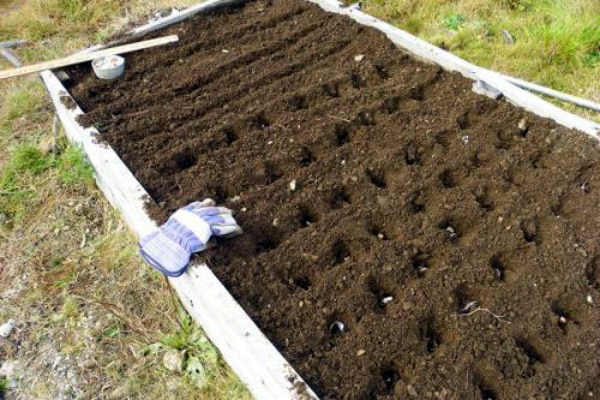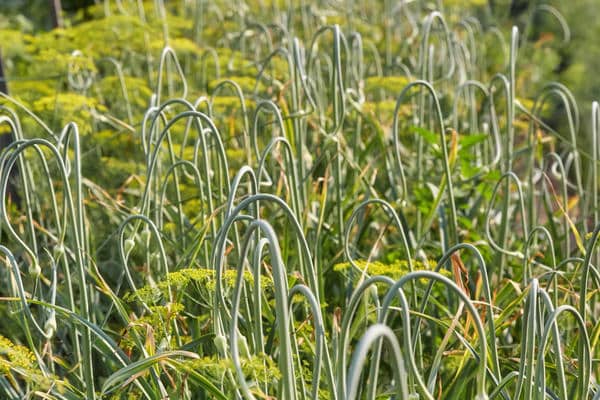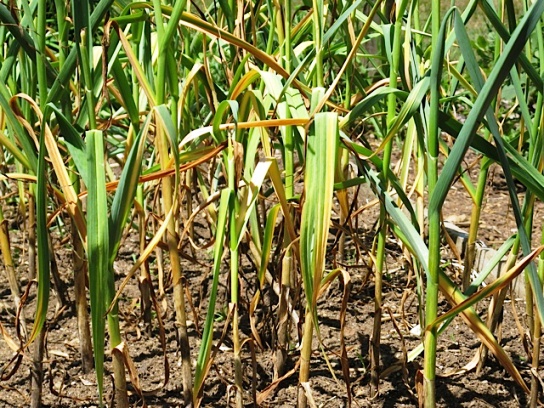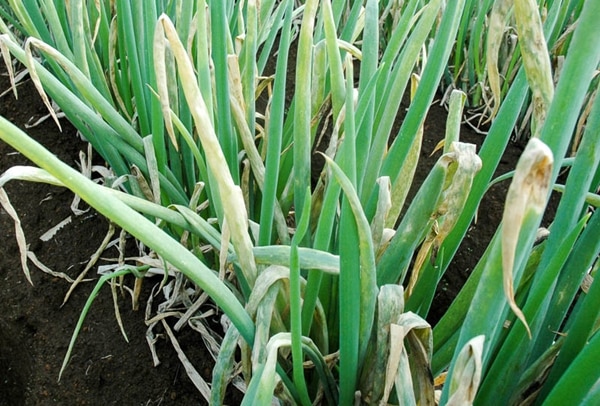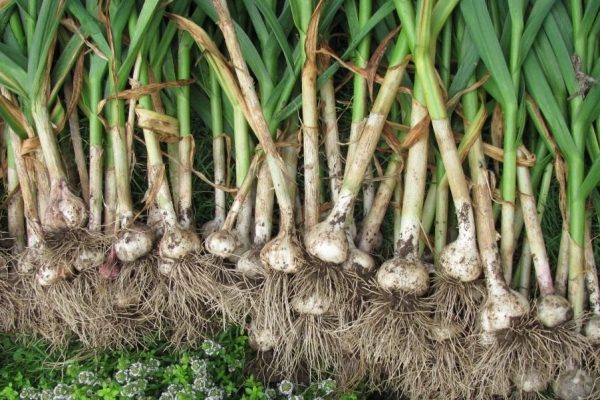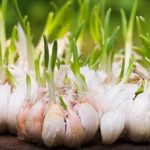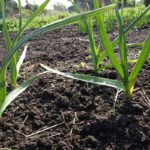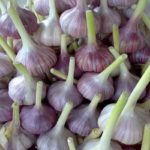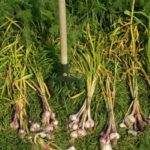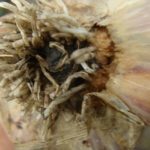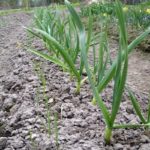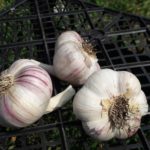There are many reasons why garlic may grow small. The spicy vegetable is quite capricious in terms of soil composition and care, so you need to follow the rules throughout its growing season. This will allow you to harvest a rich harvest of large heads of garlic.
- Why garlic doesn't grow: reasons for poor growth
- Insufficient watering
- Poor quality seed material
- Barren land
- Other reasons
- Diseases that slow growth
- Rust on garlic: how to treat it?
- Bacteriosis or bacterial rot
- Downy mildew or peronosporosis
- Garlic fusarium, control measures
- Black and green moldy rot
- Necessary measures to enhance growth
Why garlic doesn't grow: reasons for poor growth
Garlic shrinks most often as a result of improperly prepared soil, insufficient care or due to bad weather conditions. By identifying the cause in time, you can correct the situation and reap a rich, healthy harvest.
Insufficient watering
Garlic loves moisture. Throughout the entire season, the vegetable bed should never dry out. At the beginning of summer, there is usually little precipitation, and the root system of the vegetable is poorly developed and goes shallow into the ground. Therefore, watering should be regular. If the bed dries out, small cloves will form.
With a lack of moisture, the feathers of garlic become gray-bluish in color, and the tips bend downwards. Not only lack of moisture can cause a small harvest. Excess moisture is also harmful to the vegetable. The leaves acquire a pale green color.
Poor quality seed material
The future harvest depends on the quality of planting material. A large head of garlic is formed only from large, dense cloves, without rot or mold. Even if one clove in a solid head is defective, others cannot be selected for planting. All slices selected for planting must have intact film and no damage. You can only plant dry, unsprouted cloves.
The teeth should be separated only before starting planting work. Before planting, it is useful to soak the garlic cloves in a solution with Fitosporin for 5–6 minutes. This will strengthen the immune system and disinfect the surface.
As a disinfectant, you can use a weak solution of potassium permanganate, into which the planting material is placed for 5–6 hours. After this, they are washed and placed in a bag for 2-3 days. During this time, small roots will sprout.
Barren land
Loose, light and nutritious soil is favorable for garlic.A good harvest can be obtained in the presence of soil with a neutral or moderate alkaline reaction. If the acidity of the soil is high, wood ash, which is simply sprinkled on the beds, will help reduce it.
Since autumn, fertilizers have been applied to the intended place for planting garlic. The next application of mineral and organic fertilizers should be a month before planting. As soon as the first shoots appear, it is useful to add ammonium nitrate. It activates the growth of greenery. At the moment when 4 feathers appear, the laying of the bulb begins. At this time, feed with superphosphate and potassium salt.
Experienced vegetable growers give advice on growing garlic in the garden, according to which you should not press the cloves too deep into the ground, especially if it is too loose. In rainy weather, the slices will go even deeper. Germination will be slow and delayed, and sometimes you may not even wait for germination at all.
It is better to plant the slices in previously prepared furrows, about 6 cm deep. The furrows are made at intervals of 20 cm. Such a large distance will allow light to penetrate to all parts of the plant. It is recommended to add a little superphosphate and wood ash into the furrows. The distance between the cloves is 8–10 cm. After the garlic is planted, it is covered with earth and mulched with humus or peat.
Other reasons
It is recommended to plant garlic in the bed where cabbage, legumes, pumpkin, and herbs grew last year. The vegetable feels bad if planted after tomatoes, potatoes, and onions. It has been noticed that the heads turn out larger if peppers and tomatoes are planted side by side.
You can’t plant garlic in the same place all the time. It is advisable to change the planting site at least once every two years.
If you plan to plant a vegetable for the winter, then it is best to plant it in a place where more than one crop has been harvested (not onion crops).
Garlic loves light. Even the shadow of a fence can affect the size of the cloves. Therefore, the vegetable must be planted on a dry plot of land where daylight reaches without obstacles.
The following tips will help speed up ripening and increase the size of the bulb. When the garlic has an arrow with a seed box, it is better to remove it. Some gardeners tie the feathers in a knot. These measures will allow all nutrients to accumulate in the underground part.
Another reason why the garlic bulb in the garden cracks, rots and does not grow is infection or damage by insect pests.
Diseases that slow growth
A common cause of poor garlic growth is infection. You can recognize the problem by the appearance of the plant. It usually looks lethargic, the feathers change color, the heads rot and small teeth form. If the problem is identified early, measures can be taken to stop the spread of infection.
Rust on garlic: how to treat it?
The disease begins with the appearance of yellow-orange spots on the feathers of garlic. Gradually they grow and become black. If control measures are not started immediately, all leaves become rusty and die. The supply of nutrients is disrupted, and the growth of the heads slows down.
Before planting, the cloves are placed in a weak solution of formaldehyde. Garlic should be planted in beds treated with Fitosporin (take 15 g of the drug per 10 liters of water) or Bordeaux mixture. When rust appears in the garden bed, the plants are sprayed with fungicides Hom, Kuproksat, Gamair or copper sulfate. Treatment is carried out every two weeks.A month before harvest, stop spraying.
Bacteriosis or bacterial rot
Bacteria equally often affect both vegetables in the garden and already harvested crops. The cloves begin to rot, and brown-yellow spots appear. Rot quickly covers the entire garlic head, it cracks and becomes covered with a yellowish coating. It most often develops as a result of storing unripe or poorly dried crops.
Before planting, the cloves must be etched with copper sulfate. If affected heads are found, you must get rid of them immediately. Collect only ripe bulbs from the beds and dry them well.
Downy mildew or peronosporosis
Fungal infection of garlic is common in regions where the weather is rainy and cool. First, the tops of the plant begin to turn yellow and dry. Gradually the entire leaf turns yellow, dries out and withers. The growth and development of not only the tops, but also the bulbs slows down. Garlic cloves are small, loose and tasteless.
If the garlic is sick, stop watering and adding nitrogen. It is useful to spray the leaves with any copper-based solution, for example, Hom, copper sulfate. The fight against peronosporosis is carried out with the help of drugs such as Tiram, Fentiuram, Arcerida. Young plants can be treated with a solution of Bordeaux mixture.
Garlic fusarium, control measures
In regions with a hot climate, there is a high risk of the spread of fusarium. The disease affects the bulbs. Garlic produces few cloves and they are all small in size. The first sign is yellowing and drying of the tips of the feathers. Gradually the entire leaf is affected. You can see small brown stripes on the stem. The bulbs soften, and a yellow, white or pinkish coating appears between the cloves.The roots rot and the entire plant dies.
When a disease appears, you can treat the beds with a fungicide, for example, Fitosporin, Alirin, Champion. Preventive measures include high-quality selection of planting material, timely application of fertilizers and maintaining the required level of acidity.
Black and green moldy rot
The most common disease that affects garlic collected for storage is green or black rot. First of all, the heads are affected, which after digging are poorly dried and not ripe. The bulbs soften and black or green dust appears between the segments.
It is recommended to disinfect the soil and cloves before planting. The best fight is prevention. Garlic needs to be dug up in time and dried well for two weeks.
If you do not follow the technique of planting and harvesting vegetables, then in addition to the development of rot, another problem appears - the garlic may not be divided into cloves. One of the indicators that the onion is not ripe is the absence of individual segments or they have to be separated from each other by force.
Necessary measures to enhance growth
Vegetable growers have several methods in their arsenal that are used if garlic grows poorly and the leaves turn yellow and dry. This problem often occurs due to a lack of nutrients, especially nitrogen and potassium.
You can feed vegetable beds with urea. It is more effective to carry out foliar spraying with a liquid solution. To prepare the solution, you will need to dilute 25 g of urea in 10 liters of water.
Feeding with potassium sulfate is useful. For foliar feeding, you will need 5 g of the drug, which is diluted in one liter of water.You can water the beds with a liquid solution, in this case you will need to dilute 20 g in 10 liters of water.
If a spicy vegetable grows poorly due to an increased acid reaction, it is useful to treat the area with dolomite flour in the fall or spring. You can sprinkle a little ash or make a liquid solution. It is useful to add organic fertilizers.

